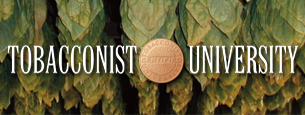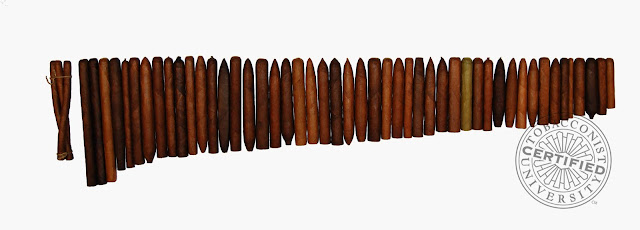CIGAR SHOP ETIQUETTE
Retail tobacconist stores must be rigorously maintained. Walk-in humidors must have their temperature, humidity, air quality, and sanitary standards perfectly maintained to preserve the cigars and protect the customers that smoke them. People walking in and out of retail walk-in humidors bring germs, dirt, and debris into the environment, so many steps must be followed to protect the cigars. While tobacconists are responsible for maintaining their shops, customers must also act responsibly and do their part. Below are some important rules to follow.
No Smoke In Humidor
The natural aromas of a walk-in humidor are subtle and delightful: the commingling of spanish cedar and tobacco aromas from around the world is a special treat. Part of the reason tobacconists make their walk-ins accessible to customers is so that they can enjoy the smell of unlit, aging tobaccos. So, do your part and refrain from smoking in the walk-in.
Be Careful Touching & Smelling
As we learned in a previous lesson, care must be taken when touching and smelling cigars: avoid touching he head and do not let it touch your nose. Always treat cigars you do not own with the highest sanitary standards.
Handle With Care
Be careful when pulling cigars out of a box as the head, foot or wrappers can easily be damaged. You might be surprised at how many cigars are ruined by careless handling; it is a significant expense to retailers. Also, remember that tobacconists spend a lot of time organizing, straightening out and facing (making sure the bands face forward) cigars. If you pull a cigar out of the box, make sure you return it to its proper position.
Damaged Cigars
Cigars can be damaged during shipping or by careless customers and/or tobacconists. Many of these are discarded or repaired and sold at a discount. Most of the damage that occurs is purely aesthetic and will not significantly effect the smoking qualities of a cigar. If you see a damaged cigar in the humidor, feel free to make an offer - a 25 percent discount might be a win-win for both you and the retailer.
Returning Cigars
Most retail tobacconists will not allow returns on cigars that have been taken out of the shop for a period of time. This is because cigars are sanitary products that must be kept at proper temperature and humidity: it would be irresponsible to accept returns. But, if you purchased several of the same cigar and found one or more to be plugged (tight or no draw), you should let the retailer know: a good retailer will do what is necessary to make it right. However, if you want to return cigars simply because they did not suit your taste preferences, that is just part of the cost of educating your palate: don't expect retailers to accept returns just because you didn't like the cigars.
Theft Is Real
People shoplift from cigar stores everyday! Even a small retail tobacconist shop can lose thousands of dollars a year from shoplifting. It is one of the most difficult challenges faced by retail tobacconists and nearly impossible to stop without creating uncomfortable customer experiences. Do your part by not acting suspicious, not touching cigars unnecessarily and not putting your hands in and out of your pockets too much. The snapshot below shows an elderly couple stealing over seven hundred dollars worth of cigars in less that two minutes!
Public Cigar Cutter Rules
Cigar cutters touch the head of the cigar that will eventually touch your mouth, so they must be kept clean. Retail tobacconists have cutters on hand for customers to use when they buy cigars, but they must also have procedures in place to keep those cutters clean. If you are going to use a shop cutter, keep the cigar out of your mouth until you have cut the cigar. And remember that you are well within your rights to ask your tobacconist about the sanitary procedures they use to keep their cutters clean.
CIGAR MYTHS
There is enough magic and wonder in the world of cigar making to make lies, myths and marketing exaggerations totally unnecessary. Yet there are innumerable untruths and half-truths in the marketplace, and many of them have been propagated for decades by successful individuals and companies. As an educated consumer we encourage you to be skeptical and continue to educate yourself from credible sources. Below is a list of some of the most popular cigar myths you will come across.
Virgin Thighs
Myth: In Cuba, cigars are rolled on the thighs of virgins.Truth: This is an absurd concept that sounds interesting and amusing to some, but it is not grounded in reality.
Cuban Seed
Myth: Cuban see equals quality.Truth: Cuban seeds, grown inside or outside Cuba, can produce both good and bad cigars. There are far too many variables impacting the quality of tobacco and cigars (ie. soil, climate, rain, fermentation, blending, rolling, etc...). This myth gained traction after the American embargo on Cuba when cigar makers wanted to enhance the perceived value of their own brands by saying that Cuban seeds were being used. To this day, many uninformed consumers visit retail tobacconists and ask for "Cuban seed" cigars, thinking that they are better. Actually, most premium cigar seed varietals originate from Cuban seeds but have been developed and grown outside of Cuba for decades. Ultimately, when you see "Cuban Seed" written on a box, it is probably a sign that the cigar maker has nothing better or more original to say about the product; and they are marketing to uneducated consumers.
Maduros Are Stronger
Myth: Maduro wrappers/cigars are strongerTruth: While maduro wrappers may undergo a longer and more rigorous fermentation, they do not increase in strength or spice. Rather, they become richer in body and a little sweeter as the sugars develop in the leaf.
Perfect Consistency
Myth: Perfect consistency exists.Truth: It is impossible to create a perfectly consistent cigar and blend from one batch to another, much less from one crop/year to another. In addition, it is impossible to construct every cigar perfectly. The nature of handmade cigars requires some deviation and inconsistency. It is perfectly acceptable for handmade cigars to be a little inconsistent. It is also okay for a cigar to burn a little crooked and require a touch-up and it is okay for cigars to taste a little different from one batch to another. In fact, the human senses cannot taste or smell perfectly, so we wouldn't recognize perfect consistency if it were possible.
Lost & Found Tobaccos
Myth: The classic marketing story about a long lost batch of perfectly conditioned tobacco being discovered and used to create a "once in a lifetime" cigar.Truth: The "truth" is hard to find in this case. Discovering the how, what, when, and where of a "re-discovered" tobacco is difficult if not impossible to prove. And even if this very special, rare, expensive "tobacco" is used in a cigar, it could be an insignificant amount: just another marketing ploy - buyer beware!
Cuban Cigars Are "The Best"
Myth: This is the mother of all cigar myths, probably because it was true half a century ago and can occasionally seem true today. Cuba is the birthplace of great dark air-cured tobacco seeds and cigars, but time has moved us forward. Great tobacconists and consumers everywhere know that our current 'golden age of cigars' exists mostly because of the efforts and products created by those outside of Cuba.Truth: Today, claiming that "I only smoke Cubans" or "Cuban cigars are the best" is merely a personal preference as opposed to objective fact. Aficionados, connoisseurs and tobacconists know that taste is subjective.
Spanish Cedar Is Necessary
Myth: Humidors and cigar boxes need to be lined with Spanish Cedar. Truth: Spanish Cedar is not necessary. It was historically and geographically convenient and practical for cigar box and humidor construction. While it may be a valid taste and aroma preference, it is not required.
Cigar Licking
Myth: A cigar should be thoroughly licked/wet-down before being smoked.Truth: This practice was common a century ago when humidification was not as accurate and consistent as it is today. Wetting a dry cigar/wrapper would help keep the cigar from unraveling, but it is not necessary when smoking a well-conditioned cigar.
Angled Cut
Myth: Cutting the cap/head of a cigar on an angle helps aim the smoke directly to the palate and enhances the taste.Truth: In contrast to the perfect cut, an angled cut jeopardizes the integrity of the cigar head and may lead to it unraveling. In addition, a mouth filled with smoke will taste the smoke, whether it is aimed at the tongue or not.
Self-Sharpening Cutter
Myth: Some double guillotine cigar cutters are said to sharpen themselves.Truth: This is false. The physics of metal sharpening have nothing in common with the way double guillotines function.
Packaging Equals Quality
Myth: It is natural to equate beauty with quality.Truth: Many cigars with simple packaging are extraordinary, and many cigars have extraordinary packing that is not commensurate with the product. The cigar industry pioneered artistic, intricate, and luxurious packaging concepts, in part, because the products look like commodities without distinguished packaging and branding. But, extraordinary packaging says nothing about the actual quality of a product.
Strength Equals Body
Myth: Full-bodied cigars are strong. Strong cigars are full-bodied.Truth: A cigar can have a full body, characterized by depth and breadth of flavor (i.e. richness, earthiness), and not be strong. Strength relates to nicotine intensity and can refer to spice levels (i.e. strong spice), but not necessarily profound, rich, or full flavors.
Flavored Cigars Are Made To Attract Children
Myth: If you believe the FDA, flavored and infused cigars are made to attract underage smokers.Truth: Nothing could be further from the truth. While the FDA claims that flavored and infused cigars are an attempt to lure underage smokers, the cigar industry has no such interest. If this were true then daiquiris, margaritas, and any sweet or fruit flavored liquors and alcoholic beverages could be accused of the same despicable goal. The truth is that adults enjoy a wide range of flavor profiles, including chocolate, vanilla, mint, herbal, etc...
Absolutes Exist
Myth: Absolute statements like, "this is the best cigar," "this brand must age ___ months/years," "Dominican tobacco is always mild," etc...Truth: Everything in the world of luxury tobacco depends on one or many variables. Every batch, type, and crop of tobacco leaf is different. There are not absolute time periods for growing, fermentation, or aging. There are not absolute ways to quantify or qualify taste. There are no absolutes in luxury tobacco- everything depends.
Finally, you have finished a well rounded educational journey. Remember that romanticism plays a big part in the world of luxury tobacco, but real romance and pleasure needs no embellishment. The actual magic and wonder of luxury tobacco is enough without the myths, hyperbole and lies. Ultimately, enhanced appreciation requires enlightenment, which requires truth... thus, the importance of education.
Click below if you would like to continue learning...
🌎
🌎














































